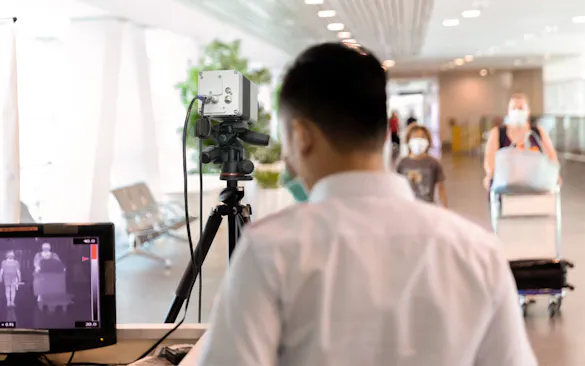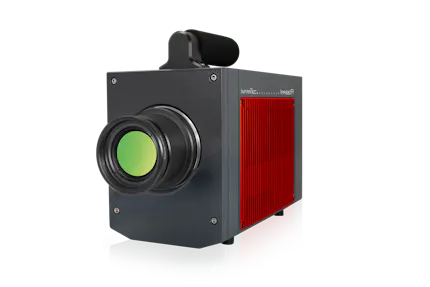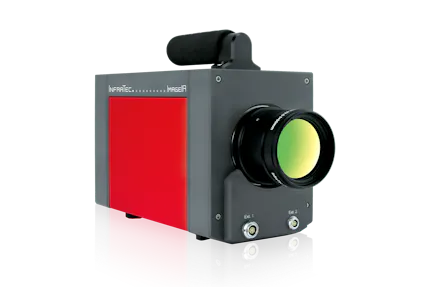Thermography in Medicine
The application of thermal imaging in human medicine is versatile and efficient
Thermography as non-contact and non-invasive process is patient-friendly
Infrared camera systems provide a detailed picture of the body temperature’s distribution in an efficient way
Thermography is able to identify various disease patterns
Imaging of smallest temperature differences in high resolution
Thermography in Human Medicine
Infrared camera systems make imaging of body temperature possible
The body temperature is an essential indicator for people’s health, and thus, much attention has been given to its determination. Measuring temperature with infrared camera systems comes with particular advantages for doctors as well for patients. As a non-contact and non-invasive diagnostic procedure, thermography is patient-friendly and does not only provide punctual temperature measurement but gives a detailed image of patients’ body temperature distribution.
Thermography has been used for a wide range of medical studies from monitoring of cardiorespiratory signals and observation of laser-based cornea operations in the eye to hygro-thermo-mechanical performance of wheelchair cushion technologies in the prevention of pressure ulcers and moisture-associated skin damages (see publications).
Thermography is a flexible and budget-friendly diagnostic method
Since multiple disease patterns can be diagnosed through information on the body's temperature distribution, thermography represents a highly flexible procedure which is, in comparison to other processes in medical engineering, budget-friendly. Thermographic diagnoses are often connected with an irritation of the body.
Thus, by applying regulation thermography, affected body parts are exposed to a cold stimulus. Healthy body regions and organs balance out this intervention on the body-heat in another way than unhealthy ones. This process is, for instance, typical for the early detection of breast cancer. However, also the correct positioning of an acupuncture needle can be controlled by an infrared camera since heat development might differentiate depending on whether the needle has been placed on the right spot or not.


Thermal Resolution of Infrared Camera Systems Determines a Successful Analysis
On applying thermography for medical diagnosis, a question arises in terms of thermal resolution, which is the infrared camera’s ability to detect smallest differences in temperature. Minimal differences in degrees Celsius (hundredth of a degree) can be a crucial factor for a successful diagnosis. InfraTec provides with its VarioCAM® series highest thermal resolutions in the uncooled infrared camera segment. These infrared camera systems can be equipped with close-up lenses in order to analyse smallest body regions in detail. Thus, skin reactions like perspiration or temperature changes of the eyes are observable in an accurate way with the help of an infrared camera.
Online Events On Demand: Thermography in Medicine
Thermography for Industrial Automation
Efficient quality control through fast, contactless temperature measurement during ongoing production
Flexible system solutions from modular components to fully customized turnkey setups
Integrated software for automated evaluation, documentation, and triggering of follow-up processes

Laser Technologies Benefiting from Infrared Thermography
Overview of laser applications and types
Fields of application for thermography in laser technologies
Technical requirements for thermographic cameras, software and accessories for successful implementation in in laser technologies
Technical Lecture “Lasers: A Versatile Heat Source for Modern Active Thermographic Testing” from Dr.-Ing. Julien Lecompagnon, Federal Institute for Materials Research and Testing (BAM)


Would You Like to Know More?
It is not unusual for tasks to be associated with special requirements. Discuss your specific application needs with our specialists, receive further technical information or learn more about our additional services.
Thermography in Veterinary Medicine
Various Disease Patterns are Detectable by Means of Thermography
Medical examinations of animals can be carried out in an efficient way by applying infrared camera systems. Their body temperature can indicate multiple health problems. These may affect the animal itself, as for instance diseases of the udder or hoof, or they result from animal husbandry, as it is in the case of an incorrect application of saddles causing pressure points and, following, local overheating on horses. Inflammation and lameness are further problems which can be detected with the help of thermography.
Infrared Camera’s Compactness and Small Size allows its Flexible Application
In particular, the application of infrared camera systems is of interest due to their high mobility and – in contrast to many other procedures of veterinary medical engineering – can, therefore, be taken into stables. InfraTec’s camera series VarioCAM® impresses especially with their small size and low weight. Moreover, thermography is a non-contact measurement process which ensures that animals are not unnecessarily provoked.

Reliable Diagnoses only with Excellent Thermal Resolutions of Infrared Camera Systems
Minimal differences of an animal’s body temperature can be an indicator for disease patterns. Thus, applied infrared camera systems must detect smallest temperature differences requiring excellent thermal resolutions. InfraTec provides with its VarioCAM® series highest thermal resolutions and minimal differences in degrees Celsius (hundredth of a degree) in the uncooled infrared camera segment.

































